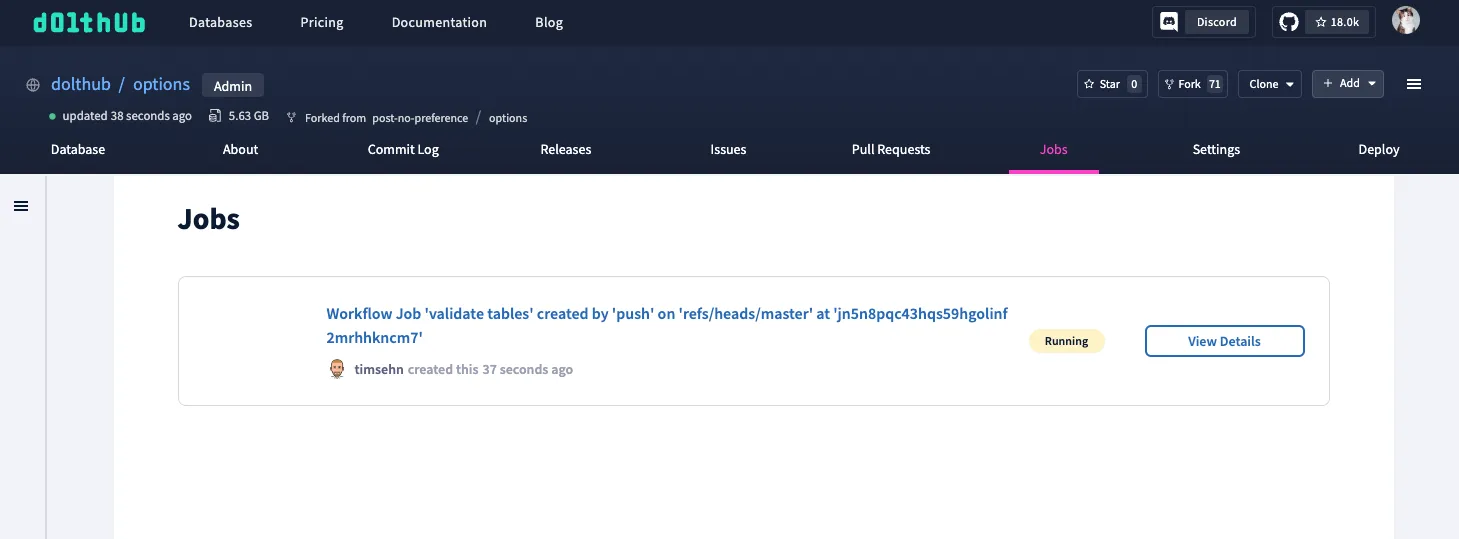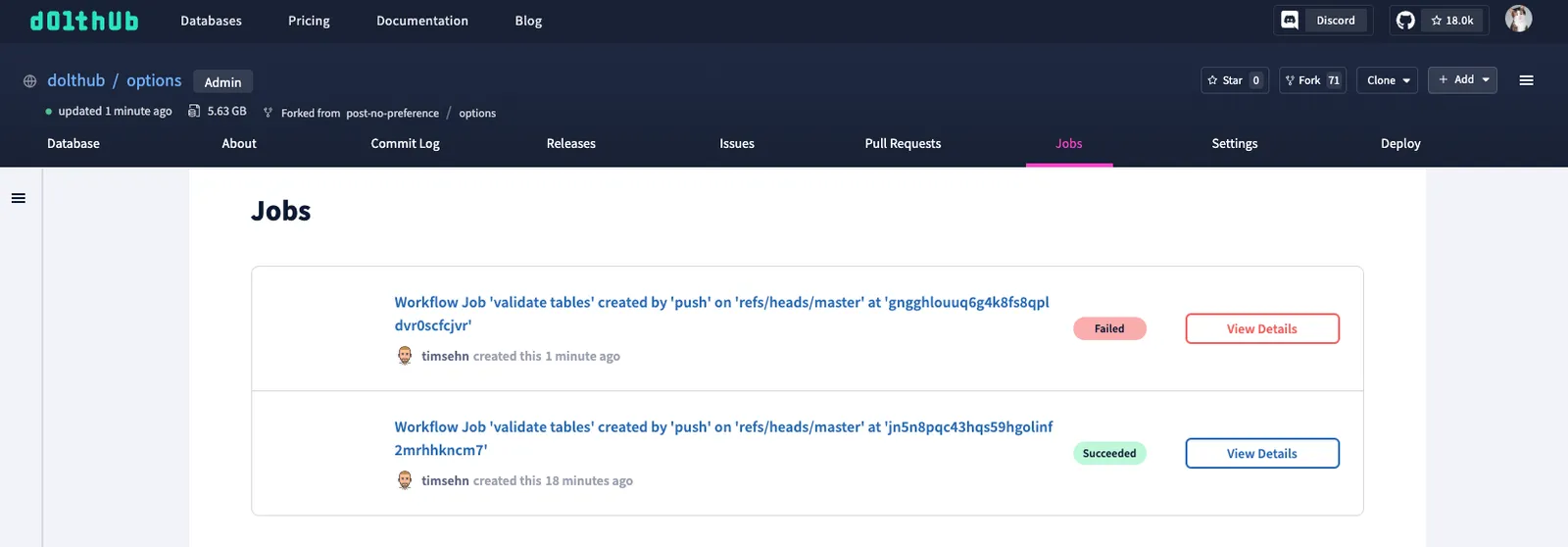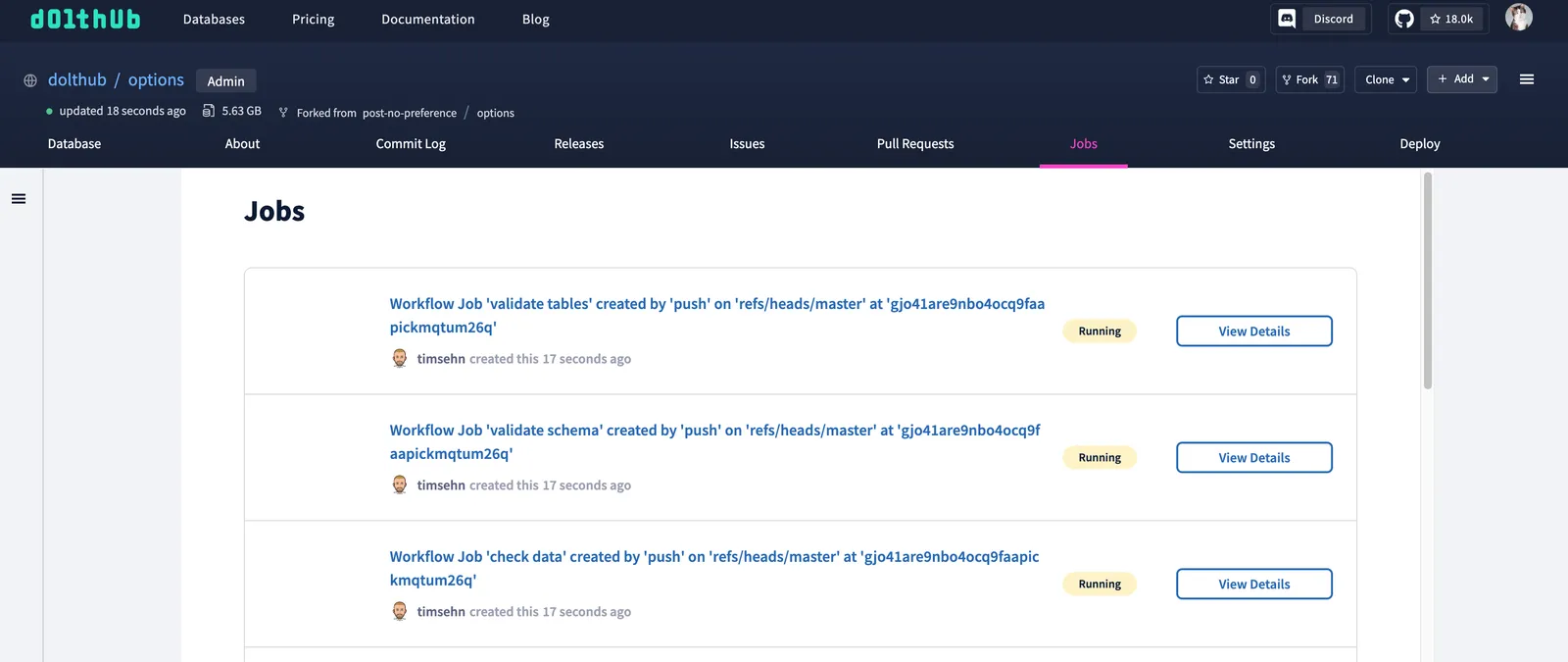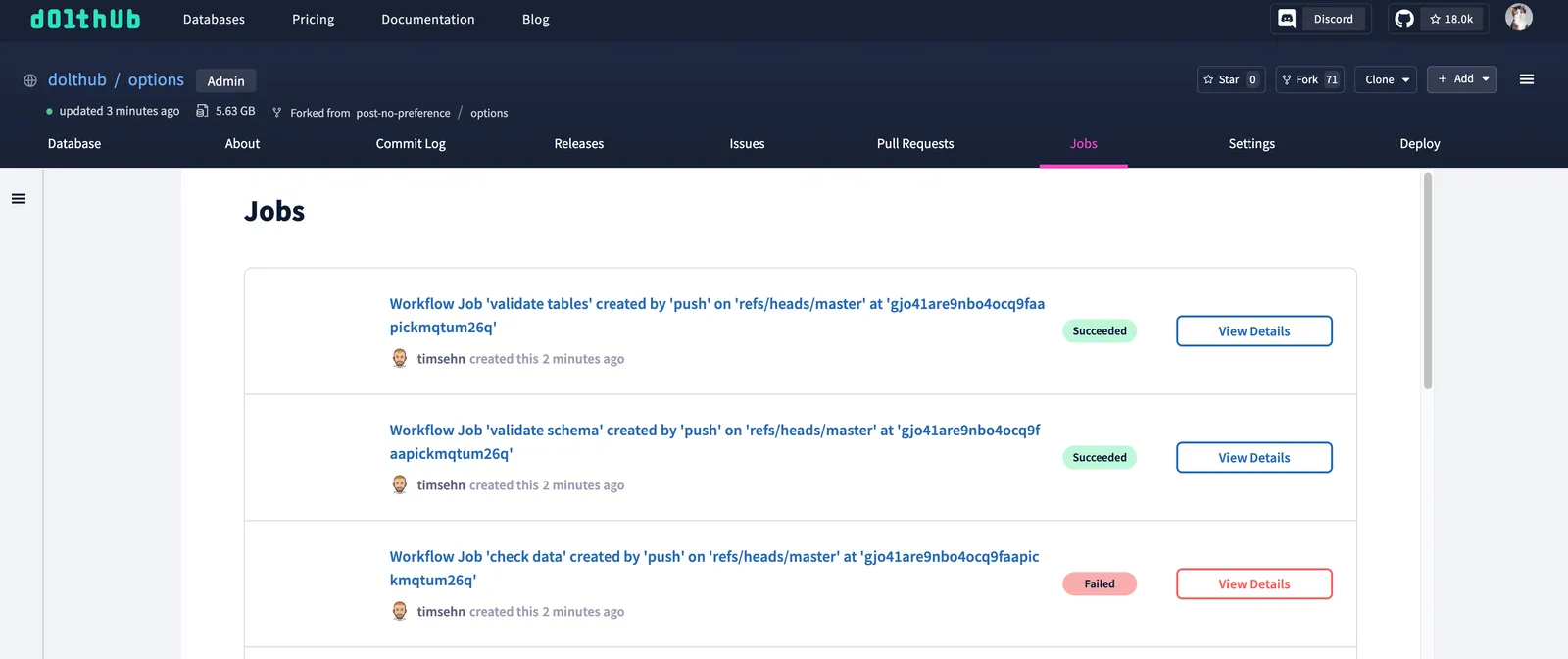Continuous integration (CI) testing is a software development practice where automated tests are run against incoming code changes pushed by software developers collaborating on a code repository. If a developer pushes changes that fail to pass the automated tests, the changes are rejected. This practice ensures that only valid, high quality changes get committed on the primary build branch, resulting in fewer bugs, and higher developer productivity.
Those familiar with Git and GitHub are likely also familiar with GitHub Actions, GitHub’s CI platform. GitHub Actions not only helps developers enforce repository standards, but also enables them to easily publish releases, automate deployments, and do much, much more.
Since Dolt is “Git for data” and DoltHub is “GitHub for databases”, a natural feature we’ve wanted to add to DoltHub for quite some time is a CI platform. Like “GitHub Actions for DoltHub”, this would allow users to automate tests and checks against their databases, unlocking truly powerful data collaboration.
Although we’re still a ways off from rolling out a “DoltHub Actions” platform, we’re super excited to announce today that CI is now available (in alpha) on DoltHub!
Today’s blog will cover how to set up CI on a DoltHub database if you’d like to try it out.
Stay tuned for future blogs that will have more feature announcements and provide more technical details of how Dolt and DoltHub implement CI.
CI starts with Dolt#
CI for DoltHub requires Dolt v1.43.14. This release contains the currently hidden dolt ci command that you will need in order to configure CI to run on DoltHub.
To get started, let’s ensure we have the correct Dolt version installed locally.
% dolt version
dolt version 1.43.14Now, let’s clone a database that’s hosted on DoltHub that we want to run CI tests on.
I’ve created the fork, dolthub/options, of the popular DoltHub databasepost-no-preference/options, and cloned a copy of my fork locally.
% dolt clone dolthub/options
cloning https://doltremoteapi.dolthub.com/dolthub/options
% cd options
% dolt status
On branch master
Your branch is up to date with 'origin/master'.
nothing to commit, working tree cleanThe first step required to enable a Dolt database to run CI is to run the dolt ci init command. This command will create Dolt’s internal CI tables and also writes a new commit to the branch.
% dolt ci init
% dolt log -n 1
commit mptat9ijrblrb2q4j2digq9miav3vfv0 (HEAD -> master)
Author: 😺😺😺😺 <dustin@dolthub.com>
Date: Wed Nov 13 15:36:27 -0800 2024
Successfully initialized Dolt CI
%After CI initialization, we need to create a “workflow” file that will define our CI tests.
Defining a Workflow#
Modeled after GitHub Action’s Workflows, Dolt CI is configured with a yaml file that gets imported into the database.
Let’s create an example workflow.yaml file now.
# workflow.yaml
name: my first DoltHub workflow
on:
push:
branches:
- master
jobs:
- name: validate tables
steps:
- name: assert expected tables exist
saved_query_name: show tables
expected_rows: "== 2"The above workflow.yaml definition should look pretty familiar to GitHub Action’s users.
It defines a new Dolt workflow named “my first DoltHub workflow” in the top-level name field, specifies when this workflow should run in the on field, and what should happen when the workflow runs, defined in the jobs field. Each of these top-level fields is required.
A Workflow’s name must be unique and is case-insensitive.
The on field defines when the workflow should run, or rather, what events should trigger the workflow to run. Currently, the only supported events on DoltHub are push events on specified branches. For this reason, the above workflow is configured to run whenever a push to this database’s master branch occurs.
jobs defines the work to be performed when the workflow is run. Each job must have a unique name and at least one step defined in the steps field. Currently, these “steps” are where Dolt CI differs the most from GitHub Actions.
In GitHub Actions, a workflow step, or action step, can be the running of an arbitrary binary or snippet of code that is executed as part of a Job. For Dolt CI, though, at least in its current form, a job step can only execute a saved query, which must be identified by name in the saved_query_name field.
A saved query in Dolt, is an arbitrary SQL query stored in the database for execution at a later time. By specifying the name of the saved query in the workflow.yaml file, we are configuring CI to execute the “show tables” saved query against the master branch, whenever a push to master occurs.
Additionally, each “step” optionally allows an expected_rows or expected_columns field to be defined, which can be used to assert the number of rows or columns in the resulting output of the saved query.
For this simple example, we will assert that the number of rows returned from our “show tables” saved query will be equal to (==), 2.
Let’s save this file, and store our new workflow in the database.
To do this, we simply use the dolt ci import <file> command.
% dolt ci import workflow.yaml
% dolt log -n 1
commit 0r25jqhrh26p0s9g7s8pes6qdrmq7bf0 (HEAD -> master)
Author: 😺😺😺😺 <dustin@dolthub.com>
Date: Wed Nov 13 15:37:01 -0800 2024
Successfully stored workflow: my first DoltHub workflow
%Like the dolt ci init command earlier, this command also automatically creates a new commit. At this point the file we created workflow.yaml is no longer needed, as the configuration has been persisted in the Dolt database.
If we ever need this file again, we can simply list the defined workflows in the database with the dolt ci ls command, then export the workflow back to yaml with the dolt ci export <workflow name> command.
% dolt ci ls
my first DoltHub workflow
% dolt ci export "my first dolthub workflow"
Dolt CI Workflow 'my first DoltHub workflow' exported to /Users/dustin/doltdbs/options/my_first_DoltHub_workflow.yaml.
% ls
my_first_DoltHub_workflow.yaml
%The final step we need to perform on our local database is to define the saved query named “show tables”.
Defining a saved query#
A saved query can be added by using the dolt sql command with the --save option. And, as the name of our saved query suggests, we’ll save the query “SHOW TABLES;”.
% dolt sql --save "show tables" -q "SHOW TABLES;"
+--------------------+
| Tables_in_options |
+--------------------+
| option_chain |
| volatility_history |
+--------------------+
% dolt status
On branch master
Your branch is ahead of 'origin/master' by 1 commit.
(use "dolt push" to publish your local commits)
Untracked tables:
(use "dolt add <table>" to include in what will be committed)
new table: dolt_query_catalogAbove we can see the expected output of the “show tables” saved query. The results have two rows, one row for each table in the database.
After creating the saved query, we can see the creation of the internal dolt_query_catalog table which stores saved queries. We now need to add and commit this new table to our database.
% dolt add .
% dolt commit -m 'add show tables saved query'
commit jn5n8pqc43hqs59hgolinf2mrhhkncm7 (HEAD -> master)
Author: 😺😺😺😺 <dustin@dolthub.com>
Date: Wed Nov 13 15:38:35 -0800 2024
add show tables saved query
%With the workflow and saved query defined on the database, we can push our updates to DoltHub.
% dolt push origin master
/ Uploading...
To https://doltremoteapi.dolthub.com/dolthub/options
* [new branch] master -> master
%Workflow Jobs on DoltHub#
Once we push the master branch, DoltHub will run our workflow for the first time. It does this by creating a new Job, in the same way it creates Jobs for pull request merges.
Workflow Jobs are visible on from the “Jobs” tab.

Here you can see the workflow job we defined in our yaml file “validate tables” is now running. Notice that for the time being, all workflow Jobs will say they were created by the database owner, regardless of the person responsible for the push event. This will be fixed at a later date.

If the workflow Job is successful, meaning the saved query succeeded and the expected number of rows were found, the Job will have status “Succeeded”. If the Job had failed, the status would be “Failed” and we would see a relevant failure message on the Job detail page.
To demonstrate what this looks like, let’s update our workflow.yaml file to include another step. This time, let’s add a step for a saved query that does not exist in the database.
# workflow.yaml
name: my first DoltHub workflow
on:
push:
branches:
- master
jobs:
- name: validate tables
steps:
- name: assert expected tables exist
saved_query_name: show tables
expected_rows: "== 2"
- name: assert table option_chain exists
saved_query_name: option_chain existsYou can see that we’ve now added a step called “assert table option_chain exists” to our workflow, which uses a saved query “option_chain exists”. Let’s import these new changes into our local database, but skip saving the saved query “option_chain exists”.
% dolt ci import workflow.yaml
% dolt log -n 1
commit gngghlouuq6g4k8fs8qpldvr0scfcjvr (HEAD -> master)
Author: 😺😺😺😺 <dustin@dolthub.com>
Date: Wed Nov 13 15:56:00 -0800 2024
Successfully stored workflow: my first DoltHub workflow
% dolt push origin master
- Uploading...
To https://doltremoteapi.dolthub.com/dolthub/options
* [new branch] master -> master
%Now with our workflow configuration updated and pushed to DoltHub, we can go check the status of our new Workflow Job.

As expected, the Workflow Job that ran on push now failed. And if we click “View details” we can see that it’s because we did not add the saved query to the database.

Ok, so let’s fix the step we just added by adding the saved query “option_chain exists” to the database and pushing the changes.
% dolt sql --save "option_chain exists" -q "select * from option_chain limit 1;"
+------------+------------+------------+--------+----------+-------+-------+--------+--------+--------+---------+--------+--------+
| date | act_symbol | expiration | strike | call_put | bid | ask | vol | delta | gamma | theta | vega | rho |
+------------+------------+------------+--------+----------+-------+-------+--------+--------+--------+---------+--------+--------+
| 2019-02-09 | A | 2019-02-15 | 65.00 | Call | 10.50 | 11.25 | 0.2705 | 1.0000 | 0.0000 | -0.0046 | 0.0000 | 0.0124 |
+------------+------------+------------+--------+----------+-------+-------+--------+--------+--------+---------+--------+--------+
% dolt status
On branch master
Your branch is up to date with 'origin/master'.
Changes not staged for commit:
(use "dolt add <table>" to update what will be committed)
(use "dolt checkout <table>" to discard changes in working directory)
modified: dolt_query_catalog
% dolt add .
% dolt commit -m 'add option_chain exists saved query'
commit g8hm71ar28djfv1q08uvphn44njuecb7 (HEAD -> master)
Author: 😺😺😺😺 <dustin@dolthub.com>
Date: Wed Nov 13 16:04:15 -0800 2024
add option_chain exists saved query
% dolt push origin master
\ Uploading...
To https://doltremoteapi.dolthub.com/dolthub/options
* [new branch] master -> masterAnd after that latest Workflow Job completes, we can see that our “validate tables” Job is passing again!

Getting fancier#
Let’s update our workflow.yaml once more, but get a little fancier with it.
# workflow.yaml
name: my first DoltHub workflow
on:
push:
branches:
- master
jobs:
- name: validate tables
steps:
- name: assert expected tables exist
saved_query_name: show tables
expected_rows: "== 2"
- name: assert table option_chain exists
saved_query_name: option_chain exists
- name: assert table volatility_history
saved_query_name: volatility_history exists
- name: validate schema
steps:
- name: assert 13 option_chain columns exist
saved_query_name: check option_chain column length
expected_columns: "<= 13"
- name: assert call_put column exist
saved_query_name: check option_chain.call_put exists
expected_columns: "== 1"
- name: assert 16 volatility_history columns exist
saved_query_name: check volatility_history column length
expected_columns: ">= 16"
- name: assert act_symbol column exist
saved_query_name: check volatility_history.act_symbol exists
expected_columns: "== 1"
- name: check data
steps:
- name: assert option_chain table has data
saved_query_name: check option_chain data
expected_rows: "> 0"
- name: assert volatility_history table has data
saved_query_name: check volatility_history data
expected_rows: "> 0"Above, we’ve done quite a bit more than before. With this updated workflow we now have added additional job definitions that will check each tables’ schema, and ensure each table has data.
After importing this new workflow.yaml into our local database, we create all of the saved queries we’ve referenced above in the file. The queries for each are shown in the dolt_query_catalog table below.
% dolt sql -r vertical -q "select * from dolt_query_catalog;"
*************************** 1. row ***************************
id: check option_chain column length
display_order: 4
name: check option_chain column length
query: select * from option_chain limit 1;
description:
*************************** 2. row ***************************
id: check option_chain data
display_order: 8
name: check option_chain data
query: select * from option_chain limit 1;
description:
*************************** 3. row ***************************
id: check option_chain.call_put exists
display_order: 5
name: check option_chain.call_put exists
query: select call_put from option_chain limit 1;
description:
*************************** 4. row ***************************
id: check volatility_history column length
display_order: 6
name: check volatility_history column length
query: select * from volatility_history limit 1;
description:
*************************** 5. row ***************************
id: check volatility_history data
display_order: 9
name: check volatility_history data
query: select * from volatility_history limit 1;
description:
*************************** 6. row ***************************
id: check volatility_history.act_symbol exists
display_order: 7
name: check volatility_history.act_symbol exists
query: select act_symbol from volatility_history limit 1;
description:
*************************** 7. row ***************************
id: option_chain exists
display_order: 2
name: option_chain exists
query: select * from option_chain limit 1;
description:
*************************** 8. row ***************************
id: show tables
display_order: 1
name: show tables
query: SHOW TABLES;
description:
*************************** 9. row ***************************
id: volatility_history exists
display_order: 3
name: volatility_history exists
query: select * from volatility_history limit 1;
description:
%After we push these new changes to DoltHub, they’ll be live.
Now, let’s say that hypothetically, a new committer, unaware of the updated workflow we’ve defined, comes along and decides to delete all data from the option_chain table and pushes this change to master.
% dolt sql -q "delete from option_chain;"
Query OK, 71203454 rows affected (0.00 sec)
% dolt status
On branch master
Your branch is up to date with 'origin/master'.
Changes not staged for commit:
(use "dolt add <table>" to update what will be committed)
(use "dolt checkout <table>" to discard changes in working directory)
modified: option_chain
% dolt add .
% dolt commit -m 'remove option_chain data'
commit gjo41are9nbo4ocq9faapickmqtum26q (HEAD -> master)
Author: 😺😺😺😺 <dustin@dolthub.com>
Date: Wed Nov 13 19:00:31 -0800 2024
remove option_chain data
% dolt push origin master
- Uploading...
To https://doltremoteapi.dolthub.com/dolthub/options
* [new branch] master -> masterOur updated workflow defined for this database will kick-off each of the Workflow Jobs, as seen in the image below.

But, we’d expect the “check data” Workflow Job to fail. And, it does.

If we click “View details”, we can see the failure resulted from expecting > 0 rows, but got 0.

Conclusion#
As I mentioned before, this is the earliest version of Dolt and DoltHub CI, and we’ll be shipping out rapid improvements and features in the coming weeks.
We’ve found this feature to be super exciting and inspiring and we are looking forward to helping our customers build robust CI pipelines that supercharge their databases.
We’d love for you to give Dolt CI a try and tell us what additional features you’d like to see. Swing by our Discord anytime, we’d love to chat with you.
Thanks for reading and don’t forget to check out each of our cool products below:
- Dolt—it’s Git for data.
- Doltgres—it’s Dolt + PostgreSQL.
- DoltHub—it’s GitHub for data.
- DoltLab—it’s GitLab for data.
- Hosted Dolt—it’s RDS for Dolt databases.
- Dolt Workbench—it’s a SQL workbench for Dolt databases.
